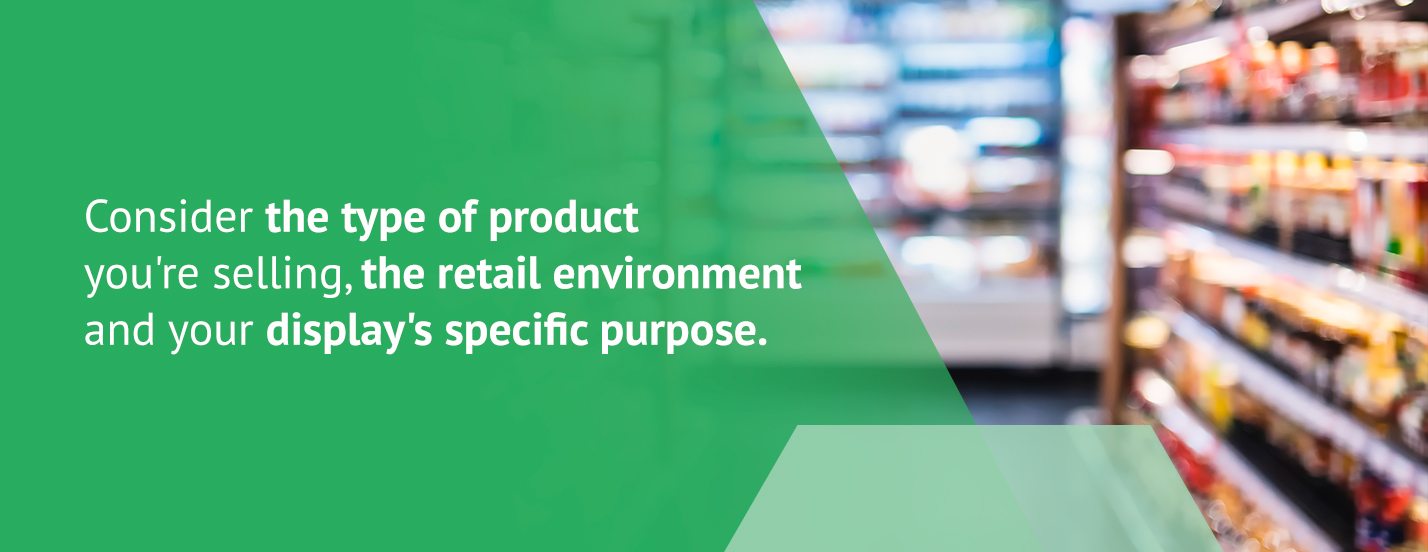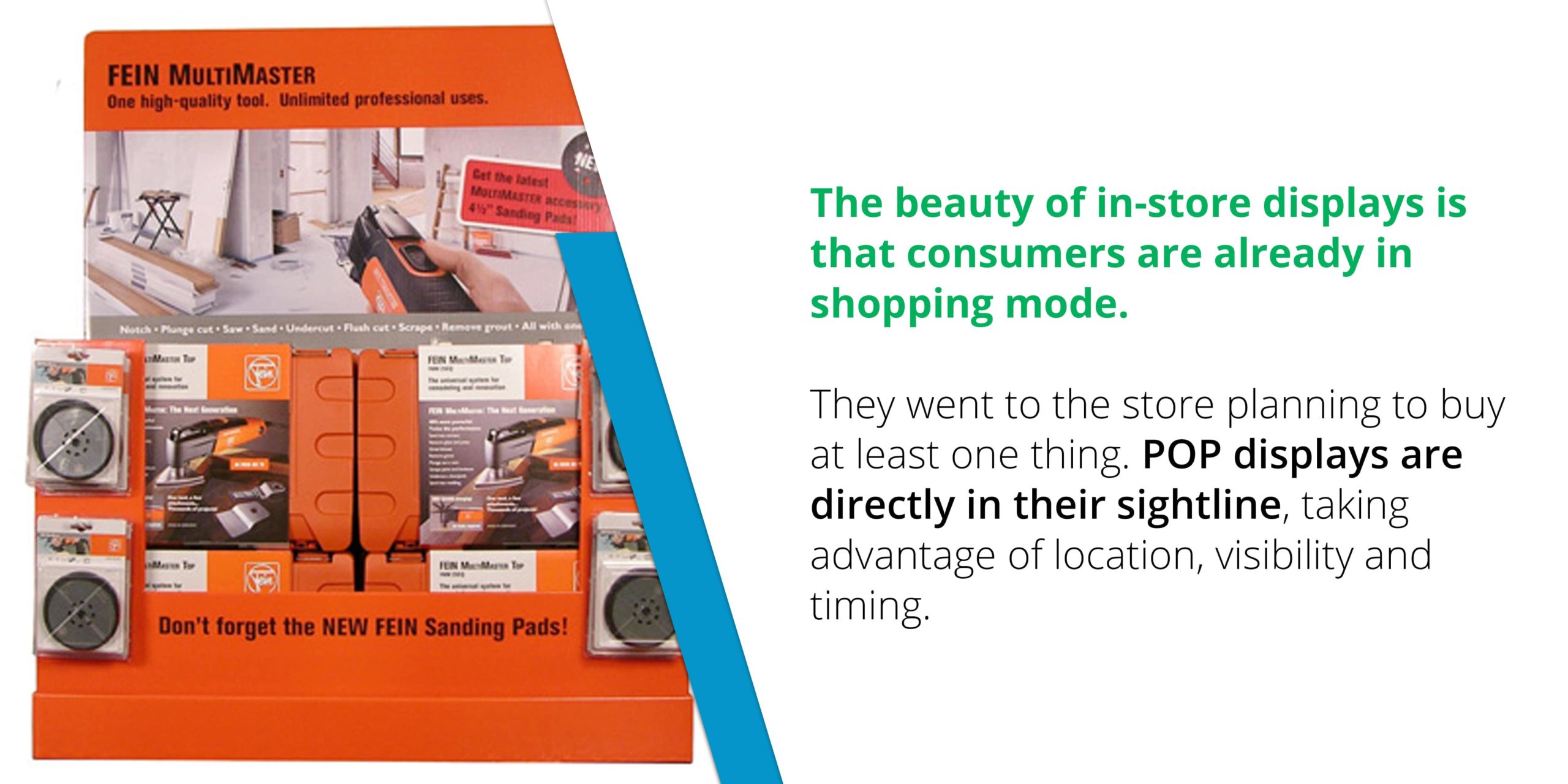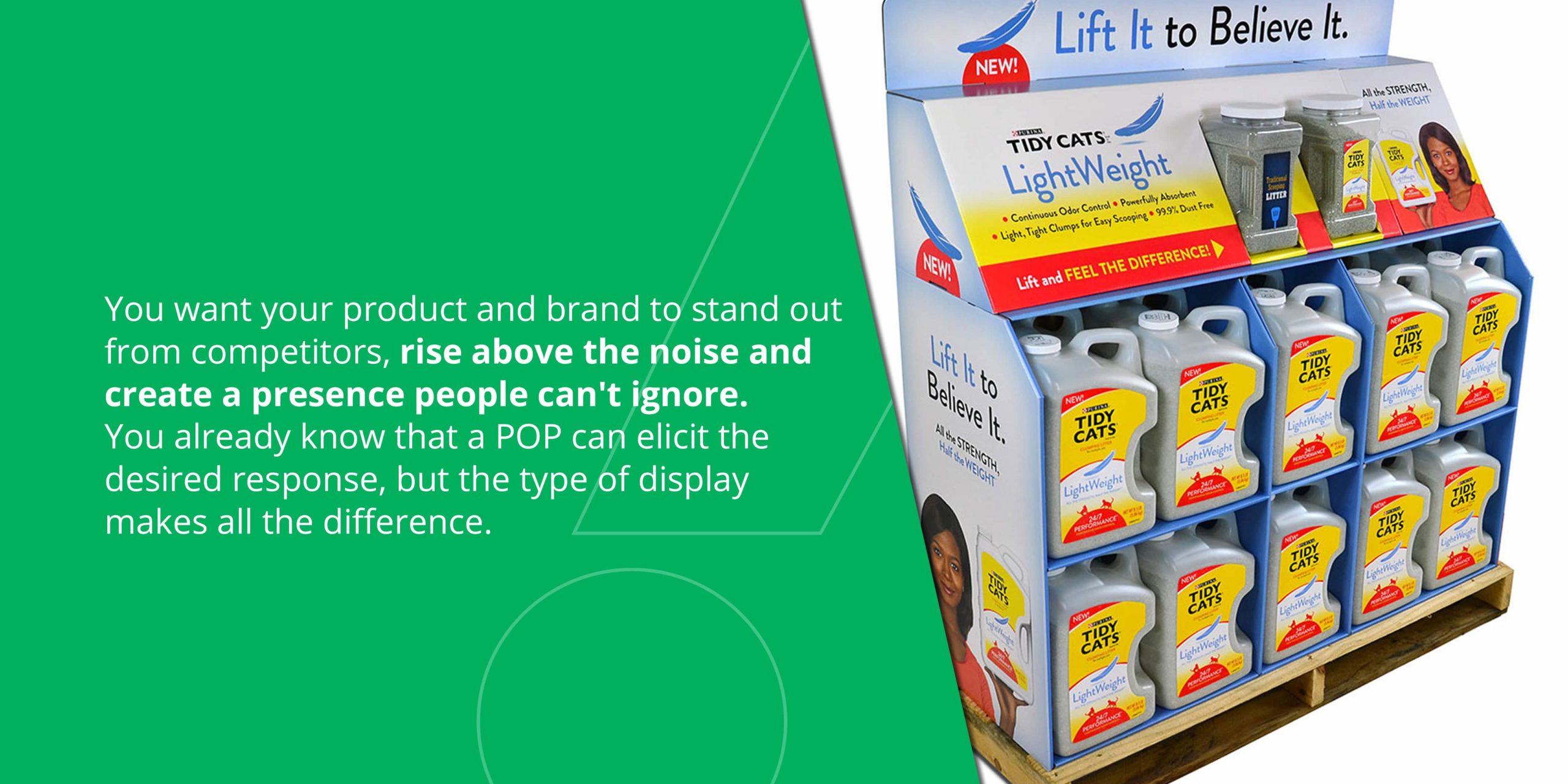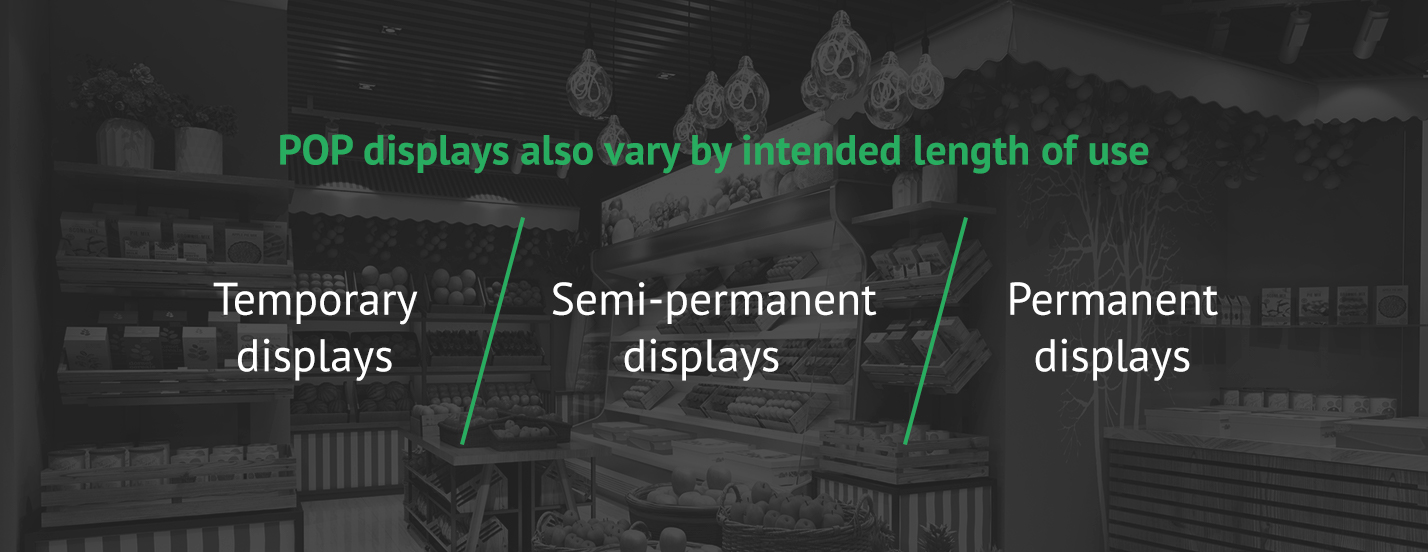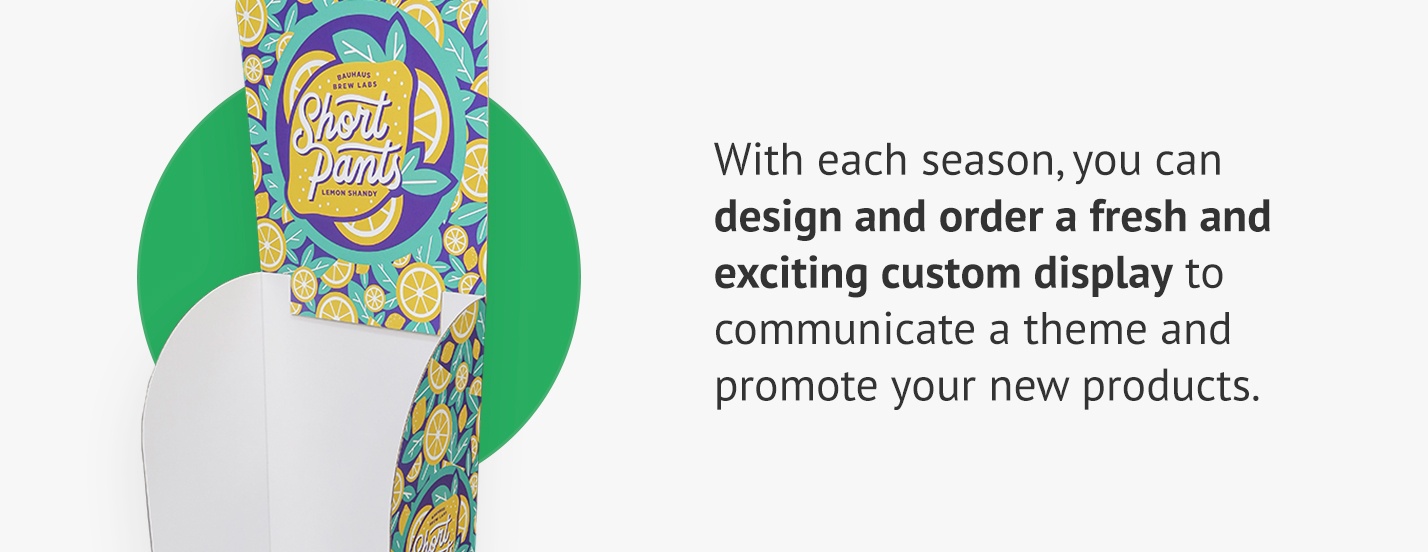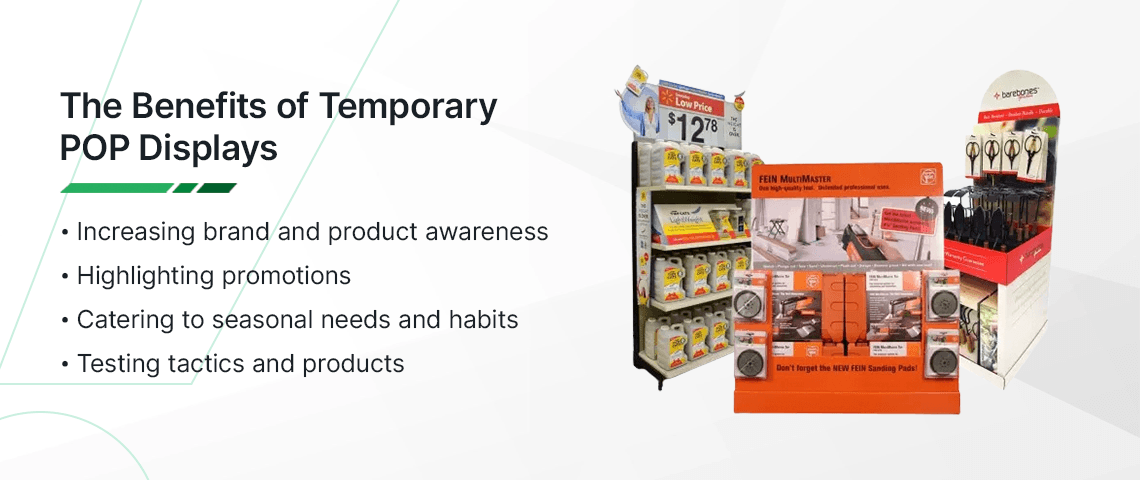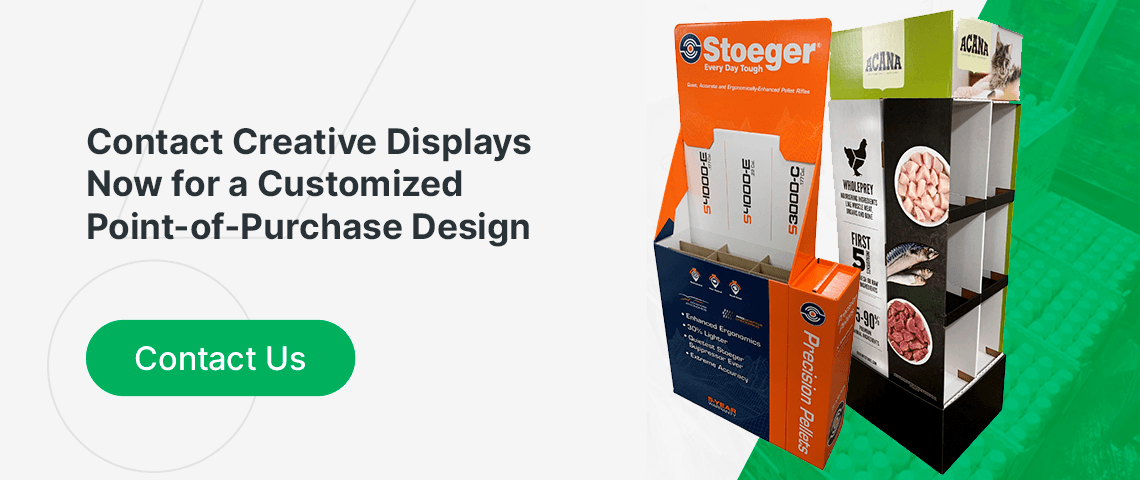Chapter 2: Types of POP Displays
Even with the growth of online shopping, consumers still prefer traditional retail stores and crave the in-person shopping experience. Approximately 58% of U.S. consumers visit a physical store at least once a week to make a purchase. While this sounds like good news to producers, millions of products are competing against each other to get from the shelf to the checkout line.
As a producer, you can spend as much money as you want on online advertising and larger-than-life marketing campaigns. But with 80% of consumers making their buying decisions when shopping, you shouldn’t overlook the potential impact of in-store displays. Point-of-purchase displays are the final form of advertisement to catch the customer’s attention and convince them to make an immediate, informed purchase.
The retail industry is growing faster than ever before. New brands are popping up daily, and retailers are constantly expanding. As a business owner or product manufacturer, it’s up to you to use all your resources to convert window shoppers into definitive buyers. And research has shown time and time again that in-store product displays are the best way to influence shoppers.
If you wish to design a POP display for your merchandise, you’ll have to select the type of display you want. Various kinds of POP displays are available, and each style is designed to fit into a store’s layout and make it easy for customers and employees to access a product. With each display type, you can choose custom designs, shapes and other features to make your products stand out.
In this chapter, we’ll cover the types of point-of-purchase advertising and how POP displays are commonly used. If you need help selecting a display that complements your merchandise and brand, let us know at Creative Displays Now.
Different Types of Point-of-Purchase Displays
Although all POP displays are meant to promote brand awareness and boost sales, some displays match certain products or circumstances better than others. When choosing the most suitable unit for your merchandise, you’ll need to consider the type of product you’re selling, the retail environment and your display’s specific purpose. To help you get started, here are the most common types of POP displays:
Floor Displays
Floor displays encompass all freestanding units, including display bins, endcaps and pallet displays. Many floor displays stand at eye level, so products are easy to notice. Since eye-level products gain a lot of attention, they typically sell better than items stocked lower or higher.
Common floor displays include shelves for placing products like drinks, toys, electronics or snacks. You might choose a floor display with hooks for hanging lightweight items like gift cards or batteries. Case stacker displays are designed to advertise larger products, such as cases of beer or soda. A case stacker display might consist of corrugated cardboard wrapped around the stacked product, featuring colorful graphics and the brand’s logo.
Like any POP display, you’ll get to customize the configuration and add unique structural elements if you wish. A manufacturer will create every aspect of the display for your brand, specifications and marketing goals.
Counter Displays
Counter displays are moveable units designed to sit on a flat surface. They’re ideal for checkout counters and encouraging impulse buys. You’ll often find counter displays holding small seasonal or consumable items like gum, candy, lip gloss and hand sanitizer.
Even though counter displays are typically small, they can still pack a punch with bright colors and vibrant images. If you have products that consumers are likely to buy on impulse as they wait in the checkout line, a counter display might be the perfect fit.
Pallet Displays
Pallet displays are floor displays that get placed on top of a wooden pallet. These sturdy displays are perfect for promoting a large quantity of merchandise and are suitable for spacious big box stores like Wal-Mart or Target.
Pallet displays help products move because they are highly visible, and customers can grab items from the display from all four sides. Due to their size, pallet displays are often fully assembled at the display manufacturer, with the product ready to go. Once the display arrives at the retailer, employees only have to place it in its assigned spot with a forklift.
If you want a heavy-duty display that’s easy to access but need something smaller than a full pallet, you can also choose half or quarter pallets. At Creative Displays Now, we’ll help you find the right pallet display for your needs and the retailer’s specifications.
Endcap Displays
Endcap displays are placed at the end of aisles, and they might consist of a freestanding unit, retail signage or inline displays arranged on gondola shelving. These displays are highly effective for increasing visibility and boosting sales. This is because many customers don’t go down every aisle, but they’ll still see products displayed in endcaps as they walk through the store.
Endcap displays also signify a bargain. According to the North American Retail Hardware Association, customers assume that products displayed in endcaps are on sale, even if they are selling at regular prices. For these reasons, product manufacturers consider endcap displays prime retail real estate.
These displays are typically used for advertising new or seasonal products or for promoting on-sale items. Endcap displays also often include a theme. For example, an endcap display might contain back-to-school supplies or snacks and drinks for a Super Bowl party. Retailers might place endcap displays near similar products or add-on items to encourage buying multiple products.
Sidekick Displays
Sidekick displays, also called power wings, are small and light. These displays are often attached to endcaps to highlight add-on items.
For example, if an endcap display is stocked with coffee, a sidekick might contain coffee mugs to entice customers to purchase both. You’ll commonly find batteries in sidekick displays next to electronics.
When complementary products are displayed together, customers might impulsively buy add-on items to make their purchase complete. They also don’t have to work as hard to find what they need, increasing their satisfaction. Overall, sidekick displays are another way to increase sales for the manufacturer and retailer.
Display Bins
Display bins are essentially large containers. These displays typically feature a simple square or hexagon structure and are easy to set up, but they’re still created carefully to be effective and appeal to customers. You can take advantage of the bin’s size to print large eye-catching fonts and imagery.
Display bins are ideal for holding large quantities, oddly shaped items, products with no primary packaging or anything that needs to move fast. You can add inserts to display bins to organize things. Customers can quickly grab products from display bins and toss them in their carts.
Inline Displays
Inline displays are small, space-saving units typically designed to sit on a shelf. Inline displays are ideal for promoting a product with limited space and prompting customers to impulse buy or try something new.
You’ll often find inline displays advertising small, consumable items like cosmetics, candy or gum. They’re also used to promote impulse buys like magazines in checkout areas.
Gravity Feed Displays
Another popular type of retail display is a gravity feed display. These displays are great merchandising tools, as they keep products organized in a functional and beautiful way.
The sloped shelves in a gravity feed display help your selection always look fully stocked. As a consumer removes a product from the front of the display, the next item falls into place.
Choosing Temporary or Permanent Displays
POP displays also vary by intended length of use. You can choose from the following:
- Temporary displays: Temporary displays made of corrugated cardboard offer a fast, cost-effective solution. These displays are designed to last a few months and make an excellent option for promoting seasonal products, new merchandise or on-sale items. Temporary displays are versatile, lightweight, highly customizable and easy to assemble. You can also recycle temporary displays and reduce waste.
- Semi-permanent displays: Semi-permanent displays combine materials like plastic, wood or metal and are built to last about a year. Semi-permanent displays may be the right choice for displaying various products simultaneously.
- Permanent displays: Permanent displays are heavy-duty fixtures designed to last years. Since permanent displays are built to last, they’re usually made with sturdy materials like wood, steel or plastic. Permanent displays may be the go-to choice for promoting a brand long-term. In some cases, a retailer might use customized secondary pieces, like signage, to turn a permanent display into a branded piece.
If you’re struggling to decide whether you should create a temporary, semi-permanent or permanent POP display, ask yourself these questions:
- Where are you displaying your product? While a permanent display might be an excellent option for your own retail store, a temporary display may be the best choice for selling your items with a big box retailer. Retailers usually have specifications suppliers need to meet with their displays. A temporary display allows you to customize the unit to their specifications easily.
- Are you displaying seasonal items? Temporary displays are ideal for advertising seasonal items. With each season, you can design and order a fresh and exciting custom display to communicate a theme and promote your new products. You can also use a permanent display for advertising seasonal items, but it’ll probably require additional design elements, like props, to give it a seasonal feel.
- Do you need a fast solution? Permanent displays often take considerable time and effort to set up. If you need to meet a deadline with your POP display, it may be best to go with a temporary display. Temporary displays can be designed, manufactured and shipped to the retailer quickly.
The Benefits of Temporary POP Displays
Different types of POP displays can meet many marketing and sales goals, helping increase sales and brand visibility for products.
Brands can use various materials to create permanent, semi-permanent or temporary retail displays. Choosing temporary options made from corrugated cardboard can be especially advantageous for businesses.
Some key benefits of temporary POP displays include:
- Increasing brand and product awareness: Because POP displays put your products in the line of sight of customers, you can use these displays to increase brand recognition and awareness. The flexibility and customization of POP displays allow you to integrate key branding elements, like colors, logos, fonts and slogans, into the design, so customers can better remember and recognize products later.
- Highlighting promotions: Temporary POP displays are easy to set up and dismantle, making them ideal for highlighting limited campaigns and deals. Whether you’re launching a new product or offering discounted goods, POP displays help bring more attention to your brand to increase interaction during the promotion’s duration.
- Catering to seasonal needs and habits: The design customization and easy assembly of temporary POP displays help brands cater to seasonal campaigns and marketing. You can design displays that reflect different holidays while increasing accessibility and awareness of your products.
- Testing tactics and products: When launching new campaigns or products, you can use POP displays to better understand customer habits and preferences. The sales from POP displays can help brands understand if new marketing, design and sales tactics are reaching and appealing to their target audiences.
Contact Creative Displays Now for a Customized Point-of-Purchase Design
If temporary displays are what you’re after, you’ve certainly come to the right place. Creative Displays Now specializes in designing cost-effective, custom, temporary displays that are just perfect for a range of retail spaces.
Looking for a semi-permanent or permanent display of your own? Feel free to head over to our partner company, Great Northern Instore, to handle your long-term POP display needs. You can count on the same level of quality and customer service that we’re known for here at Creative Displays Now.
Our team of in-house experts is just a phone call away to help guide you through the process — contact us today to learn more!

